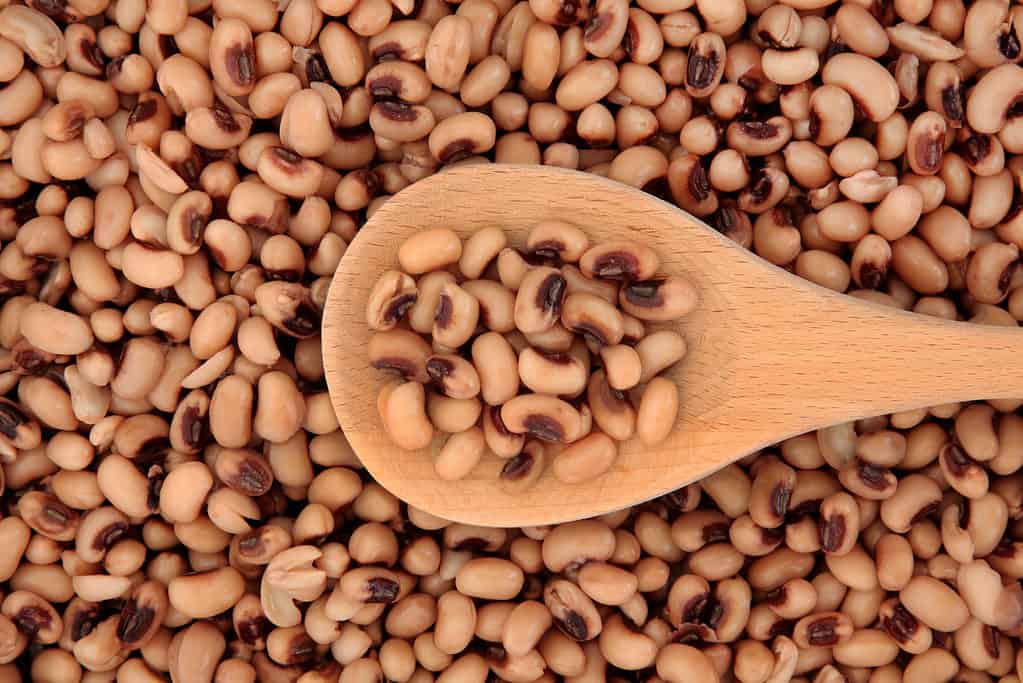Black eyed peas are a healthy fiber-filled legume containing a big dose of essential minerals and vitamins. Humans have eaten them since pre-history and because dogs have evolved alongside us for at least 11,000 years they can eat a lot of legumes too, but can dogs eat black eyed peas or are they toxic?
Your kids might not be too keen, but the good news is dogs can eat black eyed peas and benefit from their nutrients.
Can Dogs Eat Black Eyed Peas Safely?
Yes, dogs can eat a moderate amount of black-eyed peas safely because they’re non-toxic, full of nutrients, and have interesting textures, however, to be safe they should be served up plain.
Black-eyed pea salads are delicious, but they may contain lots of dog toxic ingredients like onions, garlic, and xylitol that can make your pooch really unwell. More on that later.

Yes, dogs can eat a moderate amount of plain cooked black-eyed peas safely because they’re non-toxic and full of nutrients.
©marilyn barbone/Shutterstock.com
What Are Black Eyed Peas?
Vigna unguiculata subsp. unguiculata is the scientific name for the black-eyed pea plant. It’s a subspecies of cowpea native to Africa, but it’s now grown around the world.
A black-eyed pea is the plant’s seed. Sometimes we call it a black-eyed bean or a cowpea and it gets the name from its eye which is either black, brown, green, red, or pink on a buff-brown body. No matter the shade, it’s called a black-eyed pea!
The plant was first brought to the United States by African slaves bound for Virginia in the 17th century. Black eyed peas are still considered a soul food today and they’re traditionally eaten in a dish named Hoppin’ John on new year’s day to bring prosperity.
This tasty legume has many commercial varieties, but the most common type is the Californian Blackeye. It loves hot weather, it’s extremely drought resistant, and grows strongly in hot southern states. If you buy black eyed peas in the store, they’re likely to be California Blackeye.

The black-eyed pea plant is a subspecies of cowpea native to Africa, but it’s now grown around the world.
©iStock.com/Sheila Brown
Health Benefits of Black Eyed Peas
There are lot of health benefits from black eyed peas for both dogs and humans.
Dogs can eat them because they are not obligate carnivores like cats, but omnivores. Domestic dogs are very different from their wild carnivore wolf ancestors because they’ve evolved alongside us to eat fruits, veggies, carbohydrates, and all kinds of plants including legumes. A varied diet is important for top-notch dog health and that’s where black eyed peas come in.
Black eyed peas are rich in vitamins and minerals including:
- Calcium – important for strong bones and teeth (good if your dog is lactose intolerant)
- Potassium – maintains electrical health in the nerves, muscles, and heart
- Folic acid – essential for the production of red blood cells and metabolic health
- Iron – helps produce red blood cells
- Fatty acids – for a strong immune system and glossy coat
- Vitamin K – essential for efficient blood clotting
- Amino acids – maintain healthy skin and coat, support muscles and boosts immunity
They’re Low Fat
Black eyes peas have very little fat in them which is good news for dogs who can easily pack on too many pounds. The Association for Pet Obesity Prevention says 56% of dogs are overweight in the States (that’s around 50 million dogs). Being overweight can lead to diabetes and an increased risk of cancer plus it really decreases their quality of life.
Another great plus is that black eyed peas are so low in fat they shouldn’t cause pancreatitis. This is a painful disease whereby the pancreas becomes inflamed and releases food-digesting enzymes when they’re not required. It’s set off by fatty or oily foods and often reoccurs in dogs. It’s an expensive business getting pancreatitis fixed each time.

Black eyes peas have very little fat in them which is good for managing your dog’s weight.
©Boryana Manzurova/Shutterstock.com
They’re Filled With Fiber
Black-eyed peas are also packed with fiber which not only contributes to regular bowel movements and a healthy gut, it aids satiation. Satiation is the sensation of feeling full and it’s important for dogs who are miserable and can be badly behaved if they are hungry.
Dogs on a diet can benefit from the low-fat, high-protein, high-fiber nature of black-eyed peas. These legumes can be both nutritional and help your pup feel fuller for longer.
Risks of Black-Eyed Peas
There are very few risks associated with black eyed peas but here are a few things to be aware of.
Fiber
They are stuffed with fiber so eating a lot can cause a gastric upset in the form of flatulence or diarrhea. Start off with small amounts and see how your dog goes.
The ASPCA recommends extra foods should only add up to 10% of their daily intake, but this may be too much fiber for your dog because some are more sensitive than others.
They Must be Plain
Plain black eyed peas are good for dogs, but when flavorings are added it gets dangerous.
Dogs should not eat salt, sugar, xylitol, spices, garlic, or onions which are common in black eyed pea dishes. Stick with plain black eyed peas to be safe.
Can Dogs Eat Raw Black-Eyed Peas?
Cooked black eyed peas are best because they contain a small amount of saponin which is toxic in large amounts and may cause a tummy upset. Cooked black eyed peas are also easier to digest and they’re tastier too.
You can simmer or steam them with water, but avoid using oil if you bake or fry them because it just adds fat to the meal and turns a healthy treat into something they shouldn’t be eating.
How to Give Dogs Black-Eyed Peas
Fresh black eyed peas are best, but if you need to use a tinned version be sure to wash them under a running tap to remove any preserving liquids first. Tinned black eyed peas are often stored in brine or sodium-filled liquids which aren’t good for dogs.
Start with a small amount and wait a few days to see if your dog tolerates them. If they don’t react you can feed them black eyed peas on their main meal, as a treat, or cooked up in homemade dog food.
Pups, elderly dogs, or poorly pooches might benefit from mashed black eyed peas to make them easier to chew and digest.
How Many Is A Good Amount?
Sprinkle a few on their food or just give them a handful throughout the day as a treat, but no more than 10% of their daily intake is recommended otherwise it can contribute to weight gain.
If you’re planning to add black eyed peas to your dog’s diet, don’t give them other legumes or greenery on the same day as all that fiber might upset their digestive systems.
If they do develop diarrhea or flatulence, swap out their regular meal for several small portions of plain rice and chicken or sweet potato with turkey until their stools firm up. Gastric upsets that last more than a few days ideally need a vet check-up because dehydration could become a problem.

When feeding your dog black eyed peas you can add them to their main meal, use as a treat, or cooked up in homemade dog food.
©Africa Studio/Shutterstock.com
What Foods Should Dogs Avoid?
Plain cooked black-eyed peas are great for dogs, but there are some food and drinks that are toxic. Never give your pooch the following:
- Grapes – contain compounds that cause organ failure
- Garlic, onion, leeks, shallots – alliums cause oxidative damage and anemia
- Chocolate – causes organ failure from caffeine and theobromine
- Macadamiaia nuts – contain indigestible compounds
- Alcohol – ethanol in beer, wine, spirits and alcohol-infused sweets can be fatal
- Black walnuts – their mold is a neurotoxin and the compounds are poisonous
- Xylitol – artificial sweetener than can cause hypoglycemia
- Blue cheese – the “blue” mold is toxic
Are Black Eyed Peas Good for Dogs?
Yes, black-eyed peas are good for dogs if they are cooked, unseasoned, and given in moderation.
The problems arise if they’re coated in oil, seasoned with salt, pepper, or garlic, or given in portions large enough to cause painful flatulence and gastric upsets.
A few as part of a nutritious complete meal or an occasional treat and black eyed peas are just fine!
Up Next
The photo featured at the top of this post is © Jaromir Chalabala/Shutterstock.com
Ready to discover the top 10 cutest dog breeds in the entire world?
How about the fastest dogs, the largest dogs and those that are -- quite frankly -- just the kindest dogs on the planet? Each day, AZ Animals sends out lists just like this to our thousands of email subscribers. And the best part? It's FREE. Join today by entering your email below.
Sources
- ASPCA, Available here: https://www.aspca.org/pet-care/dog-care/dog-nutrition-tips
- ScienceDirect, Available here: https://www.sciencedirect.com/science/article/abs/pii/S1938973613000305
- PETMD, Available here: https://www.petmd.com/dog/wellness/evr_dg_remedies-for-upset-stomach-in-dogs
- Medical News Today, Available here: https://www.medicalnewstoday.com/articles/black-eyed-peas-nutrition
- History, Available here: https://www.history.com/news/hoppin-john-a-new-years-tradition
Thank you for reading! Have some feedback for us? Contact the AZ Animals editorial team.






